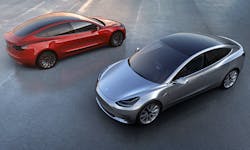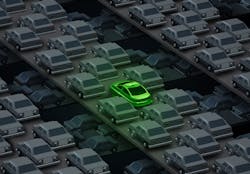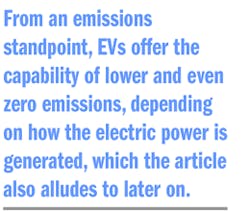Michael Wright is a NASA flight systems integration and test engineer at Goddard Space Flight Center, Greenbelt, Md. In 2007, he co-led a team of engineers to develop a linear motor for horizontal launch assist that propelled a mass to 159 mph over a distance of only 12 feet. He also has submitted patent disclosures for both linear motors for electric vehicles and inductive power for aircraft. He is author of, among other manuscripts, "Lunar Electromagnetic Launch System for In-Situ Resource Utilization" in IEEE Transactions on Plasma Science, Jan. 2011.
Michael wanted to take some time to add some extra value and clarify some points for our readers in regard to our recent article, "Charged Up: Where Do Electric Vehicles Go from Here?" The following opinions expressed do not necessarily (but may) represent those of the National Aeronautics and Space Administration.
Emissions of EVs vs. Internal Combustion Vehicles
The article begins by citing "the debate over whether EVs are actually environmentally superior and more cost-efficient [effective] than those powered by fossil fuels." It is not clear whether there is actually a debate, or who might be "fueling" it. I suspect that any misconceptions may be a result of some of the rather controversial reports referenced later in the article.
Conversely, it is impossible for fossil-fueled vehicles to ever become zero emission, and so they will continue to be a primary source of surface transportation emissions in the U.S., along with air transport. Further, from a mechanical efficiency standpoint, traditional internal combustion vehicles are about three times less efficient than EVs, with energy wasted on drive-train losses, heat, and braking.
Cost-Effectiveness of EVs
With regard to cost-effectiveness, although it is true that EVs are currently on average more expensive than fossil-fuel vehicles, there are several reasons for this, only some of which the article addresses.
First, EVs still have a significant minority of the automobile market. While traditional auto manufacturers still pump-out over 12 million fossil-fuel vehicles each year, EVs amount to only about 4% of that—cumulatively since 2008. Non-mainstream companies, such as Tesla, cannot produce or compete with these larger manufacturers, including when it comes to government subsidies.
Also, tax incentives are extremely limited, as the article correctly points out: Current tax credits phase out after only 200,000 of a manufacturer's qualifying vehicle are sold, not annually, but since January 2010. This comes out to less than 0.5% of all cars sold in the U.S. over the same period—hardly an incentive that encourages real technological innovation, that is, innovation beyond just new information technology that makes vehicles "smart" yet does nothing to get beyond century-old internal-combustion technology.
Further, there is also marketing that still favors fossil-fuel vehicles. This ranges from manufacturer discounts to flashy television ads during the Super Bowl.
A more insidious reason for the relatively high cost of EVs is the subsidies that favor both auto manufacturers, including the historic bail-out of 2008-09 that did nothing to encourage innovation, and fossil-fuel electricity companies. In the case of the latter, oil and natural gas production has enjoyed approximately $500 billion in federal subsidies for over a century, while the renewable power industry has struggled to stay afloat. This does not account for state subsidies and tax breaks, or the use of public land for mining and drilling. It also ignores other costs of oil, including the United States' long-term involvement in the Middle East, environmental and cleanup costs associated with spills, and long-term impacts of climate change including disaster recovery.
Therefore, to make an "apples-to-apples" cents-per-mile comparison between EVs and internal-combustion vehicles, all factors throughout the life-cycle of the vehicle and its fuel much be considered. If all the direct and indirect costs of fossil fuels are taken into account, use of electricity for powering vehicles becomes more attractive.
Infrastructure
The reference to "infrastructure" refers to only EV charging systems, and electric power distribution or other propulsion systems external to the vehicle. It is noteworthy that the article mentions wireless charging, a technology that is already deployed in Europe to charge electric buses.
However, to support what must become a majority of vehicles powered by electricity, in order to reach carbon reduction goals needed to avert climate change, infrastructure must be more than simply charging stations.
First, power generation should be less centralized and more local. This is made possible by solar power and battery storage technology. Again, these technologies do not enjoy nearly the amount of government backing that fossil fuel power is afforded. In fact, it has taken far-sighted entrepreneurs like Elon Musk to advance the state-of-the-art in EV and battery technologies. If we had to wait for utility or auto industries to make progress in these areas, it would have likely taken another decade or more.
One infrastructure-related technology that has not been considered is one that we at NASA have researched and demonstrated for launching spacecraft: linear motors. Currently relegated in the U.S. to primarily amusement park rides, linear motors have the unique feature of providing a linear motive force without contacting the vehicle, powered purely by electricity.
In the concept that myself and industry colleagues conceived of, powered motor stators are buried in the roadway and simple aluminum plates are mounted under the vehicle. Thus, grid power could be used by EVs on linear-motor lanes and battery power elsewhere. If deployed nationwide, e.g., on all interstate highways, this could effectively enable unlimited range for EVs: in theory, one could drive from New York to L.A. on a single charge. Such technology could also be employed for traditional internal combustion vehicles to obviate the need for gas while driving on linear motor lanes. There is also the inherent capability of regenerative braking as well as control of speed and vehicle-to-vehicle separation distance.
Power Generation
As mentioned earlier, the benefits of EVs increase with increasing use of renewable power. Although the article cites power from natural gas as producing only about half the carbon dioxide emissions of coal, there has never been a comprehensive life-cycle analysis conducted of GHG emissions from natural gas, particularly that produced from hydraulic fracturing.
In fact, the DOE released a report in 2012 that cited natural gas as producing even more "upstream" emissions that that of coal. This is due in part to the energy required for the fracking process. This does not account for the unknown extent of emissions of methane, a more potent GHG than carbon dioxide, resulting from both the infrastructure leakage and the drilling process itself. Of course, this also does not account for the environmental cost of clean water consumption and underground water contamination as a consequence of fracking.
Deploying more solar power systems, particularly locally as mentioned above, will be critical to helping EVs become truly a zero-emission form of transportation. One way to implement local power generation is by installing panels on parking garages, or directly on EVs to provide a "trickle-charge" capability that would help reduce the time required to be connected to the gird (hardwire or otherwise).
Emissions Standards
You mentioned some relative differences in standards for EV emissions between various regions of the country, based on power plant generation technology. However, this ignores the fact that coal-fired plants will, by either regulation or necessity, be phased out eventually.
Alternative EVs
One alternative to privately owned EVs is public transportation. This includes local and regional electrified rail as well as intercity rail, like that offered in many European countries where it is considered a public service (like highways are in the U.S.). Providing more public transportation, and more that is sustainable, would not only offer alternatives to owning an individual vehicle, but also alleviate highway congestion while also improving environmental quality.



